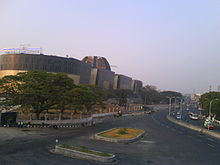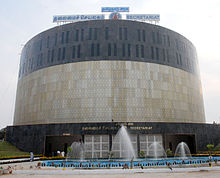- Tamil Nadu legislative assembly-secretariat complex
-
File:Tamil Nadu Legislative Assembly and Secretariat Complex as seen from Chennai MRTS.JPG
Tamil Nadu Legislative Assembly and Secretariat Complex (தமிழ்நாடு தலைமை செயலகம் மற்றும் சட்டசபை வளாகம்) also known as the Omandurar Government Estate is a complex of buildings constructed at Government estate grounds off Anna Salai in Chennai, Tamil Nadu. The complex is named after O. P. Ramaswamy Reddiyar. The building when completely constructed will house the assembly hall, secretariat and offices of the chief minister and cabinet ministers.[1] The last session in the old assembly building at Fort St. George was held on January 11, 2010 by the former DMK government. As of 24 May 2011, the new AIADMK government has abandoned the building and moved back to the former legislative building, Fort St. George. On Friday, 19 August 2011, Tamil Nadu Chief Minister Miss J Jayalalithaa announced in the state legislative assembly that the A-Block in new Secretariat complex, built by the previous DMK regime, would be converted into a multi-super specialty hospital and B-Block would be constructed as a government medical college.
Contents
History
Attempts to build a new assembly complex dates back to 1983 when M. G. Ramachandran was the Chief minister. He floated idea of constructing an assembly complex in front of Marina beach and even moving to Tiruchirappalli during severe water scarcity in Chennai city. The idea was later revived again in 2002 when J. Jayalalitha was the chief minister. She announced in the Assembly that the government was considering a 2,000-acre administrative city near Maamallapuram. Later it was stated that the proposed city would come up in Thiruvidanthai and Thaiyur villages, about 40 km south of Chennai. In January 2003, the Chennai Metropolitan Development Authority (CMDA) signed an agreement with the Construction Industry Development Board of Malaysia for a feasibility study of the administrative city project. Subsequently, Ms. Jayalalithaa informed the Assembly that as the proposed administrative city would take 15 to 25 years to build, the Secretariat would be shifted to a vacant space opposite the Marina Beach in two years. Originally, the Lady Willingdon College campus was chosen. But, since the area (about 15 acres) of the campus was found inadequate, she came up with the proposal of building a new Integrated Assembly building in the 30-acre Queen Mary's College campus, which she announced in April 2003. But this was dropped due to opposition from the political parties and the students of the concerned college.
Five months later, the government decided to establish the Secretariat over an extent of 43 acres in Kotturpuram that belonged to Anna University, the Madras University and the State Government Data Centre. The Chennai Metropolitan Development Authority was entrusted with the work of selecting the architect and the construction agency apart from being authorised to mobilise funds. It was reported that M. K. Stalin, at the time of this proposal, went to the college and supported the student's strike. In October that year, Ms. Jayalalithaa laid the foundation stone for the project. Seven months later, there was rethinking on the project.[2]
In May 2007, when the Assembly organised celebrations to mark the completion of 50 years of association of Chief Minister M. Karunanidhi with the legislature, the idea of constructing the Assembly-Secretariat complex was mooted. Mr. Karunanidhi laid the foundation stone in June 2008 and the site was formally handed over to the contractors five months later.
The New Assembly Complex
The complex is designed by German-based architect company GMP, a united venture of Meinhard von Gerkan and Volkwin Marg based at Berlin. The construction of the new assembly was entrusted to East Coast Constructions and Industries Limited.
With its highly visible dome, the complex has four circular courtyards, and the design echoes the structural features of Dravidian temple complexes in south India. The dome is modelled on the Draupadi Ratha at Mamallapuram and resembles the top of a Tamil temple car. The Assembly-Secretariat complex has two blocks — Block ‘A' and Block ‘B.' The seven-storey Block 'A' houses the Legislative Assembly Hall and the Assembly Secretariat, besides the offices of the Governor, the Chief Minister, Ministers, the Chief Secretary and certain core departments such as Finance and Home. The initial estimated cost of construction of this block was about INR 4255.7 million.
In December 2009, work on the construction of the seven-storey Block ‘B' started. With a initial cost estimate of INR 2795.6 million, the work was expected to be completed in 18 months. This block will house a host of departments.
The plinth area figures of Block ‘A' and Block ‘B' are 930,297 sq. ft. (86,460 sq. m) and 743,900 sq. ft., respectively. The dome is cast in stone and closed with glass and will function as the principal iconic element. A park has been created on the 5th floor of the Secretariat where the upper house is situated.
Revision in Project Cost
Initially, the total cost was put at around INR 7,020 million—the cost of construction of Block A was INR 4255.7 million and that of Block B was INR 2795.6 million. The revised cost as of February 2011, however, is
 10,920 million.[3] Increase in prices of inputs, additional works, design change, increase in the basement height of Block A and implementation of stringent fire safety measures and electrical safety standards as well as suggestions made from the angle of police security are cited as reasons for the increase in the project cost.[4]
10,920 million.[3] Increase in prices of inputs, additional works, design change, increase in the basement height of Block A and implementation of stringent fire safety measures and electrical safety standards as well as suggestions made from the angle of police security are cited as reasons for the increase in the project cost.[4]Canteen
The complex will have a 3,200 sq. ft. fully air-conditioned canteen on the third floor of the complex's 'A' block. The canteen can accommodate up to 200 people at any given time.[5]
Location in Context
Areas of Chennai 
Chintadhripet Park Town Island Grounds 
Chintadhripet / Anna Salai 
Chepauk  Government Estate
Government Estate 

Pudhupet Triplicane Wallaja Road Inauguration
Indian prime minister Manmohan Singh opened the building on March 13, 2010. Tamil Nadu Chief Minister M. Karunanidhi, Tamil Nadu Deputy Chief Minister M.K. Stalin, Indian National Congress President Sonia Gandhi, former Andhra Pradesh Chief Minister Konijeti Rosaiah, Karanataka Chief Minister B. S. Yeddyurappa, Tamil Nadu Assembly Speaker R. Avudaiappan, and the Madras High Court Chief Justice H. L. Gokhalae among other dignitaries attended the ceremony.[6]
The building is being constructed at a cost of more than INR 6,000 million. The dome is being const
Controversy
The building was constructed very fast in order to facilitate its opening in year 2010 which received criticism from opposition politicians. Two public interest litigations were filed by advocate M.Balaji for ADMK MLA A. K. S. Anbalagan and advocate R. Balasubramanian raising concerns about the safety of the construction. Both the petitions were dismissed by judges H. L. Gokhale and K. K. Sasidharan.[7][8]
Abandonment
As of 24 May 2011, the new state government has abandoned the building and moved back to the former legislative building, Fort St. George. The Hindu, a national daily newspaper, is sponsoring a contest among its readers to identify alternative uses for the building.[9][10] On Friday, 19 August 2011, Tamil Nadu Chief Minister Miss J Jayalalithaa announced in the state legislative assembly that the A-Block in new Secretariat complex, built by the previous DMK regime, would be converted into a multi-super specialty hospital and B-Block would be constructed as a government medical college.[11]
Trivia
The main complex has been constructed at the site on the estate where an oil expeller had been kept alongside an old building. The oil expeller was kept there as a symbol of the suffering of people during the freedom struggle. V.O. Chidambaram Pillai (1872–1936), one of the luminaries of the national movement during the pre-Gandhi era, was made to operate it when he was imprisoned at the Coimbatore central jail. Thirty-six years ago, the oil expeller was found buried in Coimbatore and brought to Chennai for display on the estate. In the late 1990s, the oil expeller was removed to the Gandhi Mandapam complex.
References
- ^ New Assembly complex to have high-rise building
- ^ The story of the search
- ^ Work apace on dome of new Assembly complex
- ^ Project cost revised
- ^ [1]
- ^ Tamil Nadu’s Legislature gets a grand, green home
- ^ Ex-MLA files case against secretariat
- ^ "HC not to stay construction of new assembly building". Timesofindia. 25 Feb 2010. p. 4. http://www.timesofindia.com. Retrieved 25 Feb 2010.
- ^ [ [2]
- ^ [ [3]
- ^ It’s going to be a multi-super specialty hospital for the poor
Categories:- Buildings and structures in Chennai
- Administrative headquarters of state governments in India
- Tamil Nadu Legislature
Wikimedia Foundation. 2010.


